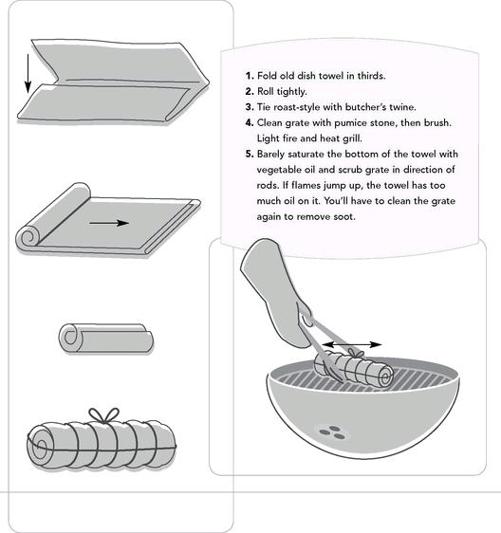I'm Just Here for the Food (9 page)
Read I'm Just Here for the Food Online
Authors: Alton Brown
Tags: #General, #Courses & Dishes, #Cooking, #Cookery

• The size, shape, and style of the grill
• The type of charcoal
• How much charcoal is involved
• How that charcoal is positioned in relation to the target food
• The outside temperature
• The outside humidity
• Available airflow
All of these factors are concerned with the management of heat. Many fine grill teachers have wrestled with this issue, and one prevailing method has emerged: It is to hold one’s hand a certain distance from the fire and count how many seconds you can stand to hold it there.
This is a fine method for the experienced griller who has learned how to interpret the information his hand/sensor gathers, but for the novice it is a buggy system at best. (See illustrations, opposite.)
The other popular method is to use charcoal volume as a guide. You often see references to “a chimney starter’s worth of charcoal” or “about a quart.” This is not a bad point of reference if you’re using something standard like briquettes, but for lump it’s a little dicey. Besides, the volume system doesn’t take arrangement and distribution into account, and that’s probably the biggest factor in grilling.
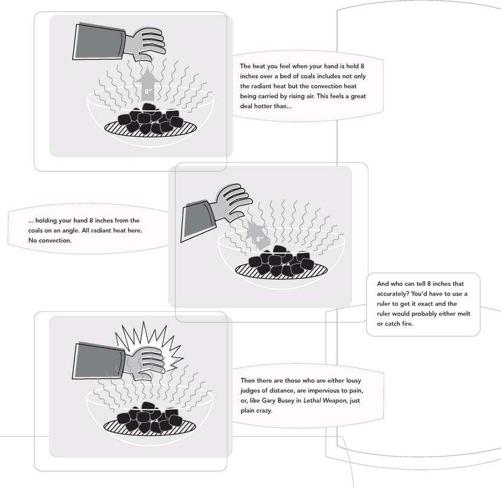
MORE LORE
Until 1951 all grills were “table” grills. Since the food had to be cooked directly over the coals, the only way to control the heat was to move coals around by reaching though the grates and pushing them. Such devices were extremely limited in scope—not to mention incredibly unsafe due to their high centers of gravity.
Then along came a genius. Like the rest of postwar America, George Stephen enjoyed backyard cooking. But George chafed at the lack of control he had over the grills of the day. He lived in Illinois, where the wind would whip in from the prairie and blow out his fire.
George worked at the Weber Brothers Metal Works, a company known for its darned fine marine buoys. Legend has it that one day George was fastening the bottom to the top of a buoy when, like the monkey picking up the bone in
2001: A Space Odyssey
, the potential gradually dawned on him. He took home some scrapped parts and created the first kettle grill. Friends and coworkers were shocked and surprised by both the quality and consistency of his creation. George headed up the new barbecue division of Weber Brothers and things must have worked out, because in 1965 the company became Weber-Stephen and has been ever since. Today George occupies a rightful place next to Prometheus on the high throne of fire.
PRE-1951 GRILL
Bright red paint job can’t camouflage medieval design. Charcoal goes in the bottom, food goes on the grate. Okay for cooking a thin steak but outside of that, not great.
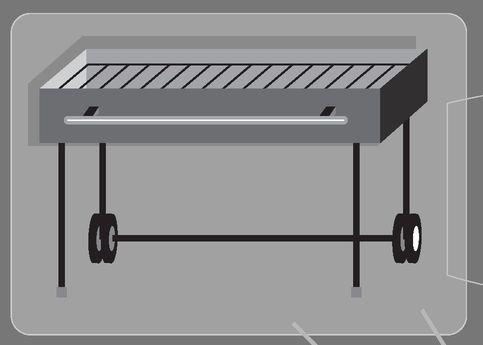
POST 1951
Brave new grill. George Stephen’s grill was the Volkswagen Beetle of the cooking world—it changed everything.The lid, spherical shape, and air vents made it possible to control heat levels by controlling air flow. Since heat could convect throughout the vessel, indirect-heat grilling suddenly became possible. Lacking vision, the Nobel Prize committee failed to acknowledge Stephen.
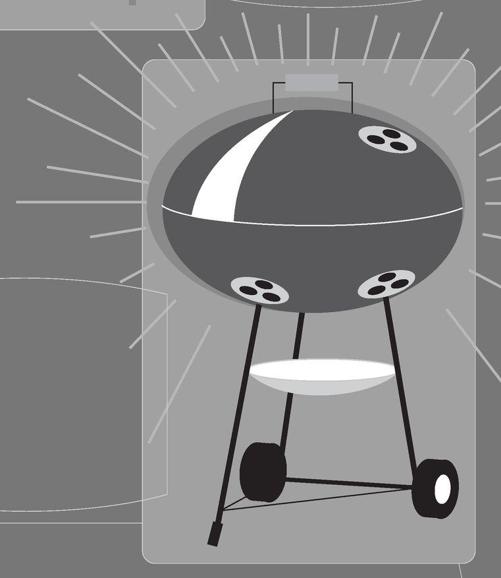
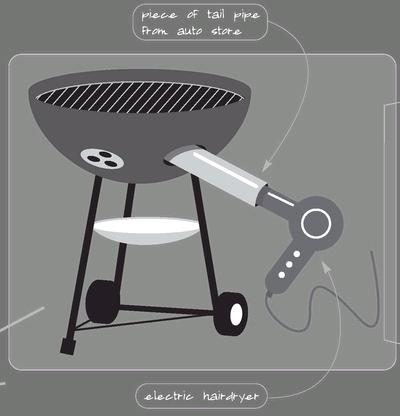
In 2004, I hooked a gas-powered blower to a trailer-sized rental grill. Several metal parts melted. It was a beautiful moment.
AB WEBER MODIFICATION V1.0
No one at Weber knows I’ve done this and I’m confident that if they knew they wouldn’t like it. I removed the rotating cover plate from one of the bottom air vents and fitted it with a length of tail pipe and a hair dryer. Essentially, I’ve turned the grill into a blast furnace capable of generating enough heat to please the average blacksmith. I got the idea after seeing a chef in Italy cook steaks over a fireplace grate after whipping the fire into a frenzy with a hair dryer. Why does it work? Remember, combustion is really a chemical reaction in which the carbon in the charcoal (or any coals for that matter) has a thermal fling with air. More air, more combustion, more heat available for radiating to a target food. I’m contemplating a new version utilizing the motor out of an old vacuum. Oh and by the way, if you do this and burn the house down, you’re on your own.
CARDBOARD BOX SMOKER

MY GRILLS
First there’s my hulking Bar-B-Chef, manufactured by Barbecues Galore, an Australian company. This very stout piece of ordnance has an actual coal elevator inside that allows you to crank the coal grate up and down in relation to the food, which sits on heavy, wide, cast-iron grates above. It’s wonderful for direct-heat grilling and for rotisserie work. For all indirect cooking (what I call grill roasting), I have a 22½-inch-diameter Weber 1-Touch Gold (meaning it has an integrated ash catcher). It’s bright orange and I love just about everything about it. Of course, I’ve made some modifications (see illustration, above) that I’m not sure the folks at Weber-Stephen would endorse, but hey, what they don’t know won’t hurt ‘em, right? I’ve also got a couple of Smokey Joes, which look like the 1-Touch’s spawn. They’re great travel grills and capable of some lovely tricks of their own.
CLEAN YOUR MACHINE WHERE IT COUNTS
It may look like a beat-up ’74 Gremlin on the outside, but your grill grate had better be squeaky clean or food will absolutely, positively stick, especially high-protein items like meat. Not only will sticking badly damage the food, it removes those groovy (literally) grill marks. Now, I’m not a very neat person, but here’s my plan: I never clean the grate after I use it; I clean it before I use it.
GRILL TOOLS
Essential
•
fire extinguisher
•
spring-loaded tongs (long)
•
stem-style analog thermometer
•
stable table or other work surface
•
grill rag: a tied towel for rubbing down grill (see illustration, right)
•
clean platter for retrieving cooked food
•
for fish or burgers, a grill spatula
•
pumice stone for heavy crud (and light rust) removal
•
wire brush for general cleaning (the bristles need to be closely clustered and short; otherwise they’ll simply wave to either side of the grate)
•
spray bottle or squirt gun for putting out flare-ups
•
digital timer
Awfully Nice But Not Essential
•
grill light for night maneuvers
•
metal skewers
•
sauté basket (looks like a giant square metal ashtray with lots of holes drilled in it)
•
portable hairdryer (for churning up the fire)
•
ash bucket
•
small metal trash can with lid for charcoal storage
•
fire stick for lighting fires
•
fireproof mat for underneath grills on decks or wooden structures
